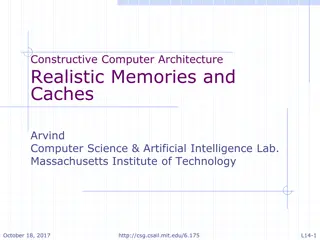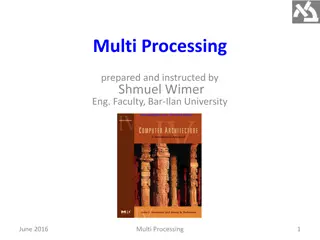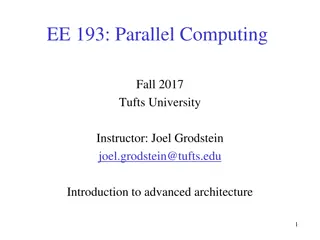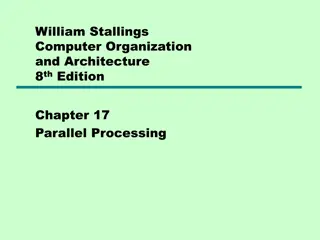Understanding SIMD in Computer Architecture
SIMD (Single Instruction Multiple Data) architecture plays a crucial role in optimizing performance for parallel computing tasks. It allows for the simultaneous processing of multiple data elements, enhancing efficiency in various applications. The concept is rooted in executing the same operation across multiple data tuples independently, leading to significant performance gains. SIMD architectures like MMX are designed to cater to multimedia applications and have evolved to be a standard feature in modern CPUs. This architecture, with its data parallel execution model and focus on replicating datapaths, offers a scalable and efficient solution for processing tasks in tandem across processing elements. By understanding the motivations and principles behind SIMD, developers can leverage its capabilities for enhanced performance in a wide range of applications.
Download Presentation

Please find below an Image/Link to download the presentation.
The content on the website is provided AS IS for your information and personal use only. It may not be sold, licensed, or shared on other websites without obtaining consent from the author. Download presentation by click this link. If you encounter any issues during the download, it is possible that the publisher has removed the file from their server.
E N D
Presentation Transcript
SIMD Single Instruction Multiple Data
SIMD: Motivation Contd. Recall: Part of architecture is understanding application needs Many Apps: for i = 0 to infinity a(i) = b(i) + c Same operation over many tuples of data Mostly independent across iterations Portions from Hill, Wood, Sohi and Smith (Wisconsin). Culler (Berkeley), Kozyrakis(Stanford).
Sequential Execution Model / SISD int a[N]; // N is large for (i =0; i < N; i++) a[i] = a[i] * fade; Flow of control / Thread One instruction at the time Optimizations possible at the machine level time
Data Parallel Execution Model / SIMD int a[N]; // N is large for all elements do in parallel a[i] = a[i] * fade; time This has been tried before: ILLIAC III, UIUC, 1966 http://ieeexplore.ieee.org/xpls/abs_all.jsp?arnumber=4038028&tag=1 http://ed-thelen.org/comp-hist/vs-illiac-iv.html
SIMD Processing SIMD SCALAR (1 operation) (N operations) r2 r2 r2 r2 r2 r2 r1 r1 r1 r1 r1 r1 + + + + + + r3 r3 r3 r3 r3 r3 add r3, r1, r2 add r3, r1, r2
TIME C2 C7 C9 C10 C1 C4 C8 C3 C5 C6 fetch decode rf exec exec wb wb exec wb fetch decode rf exec exec wb wb exec wb
TIME C2 C7 C9 C10 C1 C4 C8 C3 C5 C6 fetch decode rf exec exec wb wb exec rf wb exec exec fetch decode wb wb exec rf wb exec exec fetch decode wb wb exec wb
SIMD Architecture CU CU regs PE PE PE ALU MEM MEM MEM Replicate Datapath, not the control All PEs work in tandem CU orchestrates operations
Multimedia extensions SIMD in modern CPUs
MMX: Basics Multimedia applications are becoming popular Are current ISAs a good match for them? Methodology: Consider a number of typical applications Can we do better? Cost vs. performance vs. utility tradeoffs Net Result: Intel s MMX Can also be viewed as an attempt to maintain market share If people are going to use these kind of applications we better support them
Multimedia Applications Most multimedia apps have lots of parallelism: for I = here to infinity out[I] = in_a[I] * in_b[I] At runtime: out[0] = in_a[0] * in_b[0] out[1] = in_a[1] * in_b[1] out[2] = in_a[2] * in_b[2] out[3] = in_a[3] * in_b[3] .. Also, work on short integers: in_a[i] is 0 to 256 for example (color) or, 0 to 64k (16-bit audio)
Observations 32-bit registers are wasted only using part of them and we know ALUs underutilized and we know Instruction specification is inefficient even though we know that a lot of the same operations will be performed still we have to specify each of the individually Instruction bandwidth Discovering Parallelism Memory Ports? Could read four elements of an array with one 32-bit load Same for stores The hardware will have a hard time discovering this Coalescing and dependences
MMX Contd. Can do better than traditional ISA new data types new instructions Pack data in 64-bit words bytes words (16 bits) double words (32 bits) Operate on packed data like short vectors SIMD First used in Livermore S-1 (> 20 years)
MMX:Example Up to 8 operations (64bit) go in parallel Potential improvement: 8x In practice less but still good Besides another reason to think your machine is obsolete ECE1773 Portions from Hill, Wood, Sohi and Smith (Wisconsin). Culler (Berkeley), Kozyrakis(Stanford).
Vector Processors VECTOR (N operations) SCALAR (1 operation) v2 v1 r2 r1 + + r3 v3 vector length add r3, r1, r2 vadd.vv v3, v1, v2 Scalar processors operate on single numbers (scalars) Vector processors operate on vectors of numbers Linear sequences of numbers Does not say that they have to be done in parallel From. Christos Kozyrakis, Stanford
a[i] = a[i] + 10 b[i] = b[i] * a[i] c[i] = c[i] + b[i] TIME C2 C7 C9 C10 C1 C4 C8 C3 C5 C6 a[i] = a[i] + 10 fetch decode rf exec rf wb exec wb rf exec wb fetch decode rf exec rf wb exec b[i] = b[i] * a[i] wb rf exec wb c[i] = c[i] + b[i] fetch decode rf exec rf wb exec wb rf exec wb
Example of Simple Vector Processor
Whats in a Vector Processor A scalar processor (e.g., a MIPS processor) Scalar register file (32 registers) Scalar functional units (arithmetic, load/store, etc) A vector register file (a 2D register array) Each register is an array of elements E.g., 32 registers with 32 64-bit elements per register MVL = maximum vector length = max # of elements per register A set for vector functional units Integer, FP, load/store, etc Some times vector and scalar units are combined (share ALUs)
Vector Code Example Y[0:63] = Y[0:63] + a * X[0:63] LD R0, a VLD V1, 0(Rx) VLD V2, 0(Ry) VMUL.SV V3, R0, V1 VADD.VV V4, V2, V3 VST V4, 0(Ry) V1 = X[] V2 = Y[] V3 = X[]*a V4 = Y[]+V3 store in Y[]
Modern Multimedia Instruction Extensions AVX Vector extension 256 bit registers 8 32b floating-point 4 64b floating-point Many new instructions


![❤Book⚡[PDF]✔ The Apollo Guidance Computer: Architecture and Operation (Springer](/thumb/21611/book-pdf-the-apollo-guidance-computer-architecture-and-operation-springer.jpg)




















